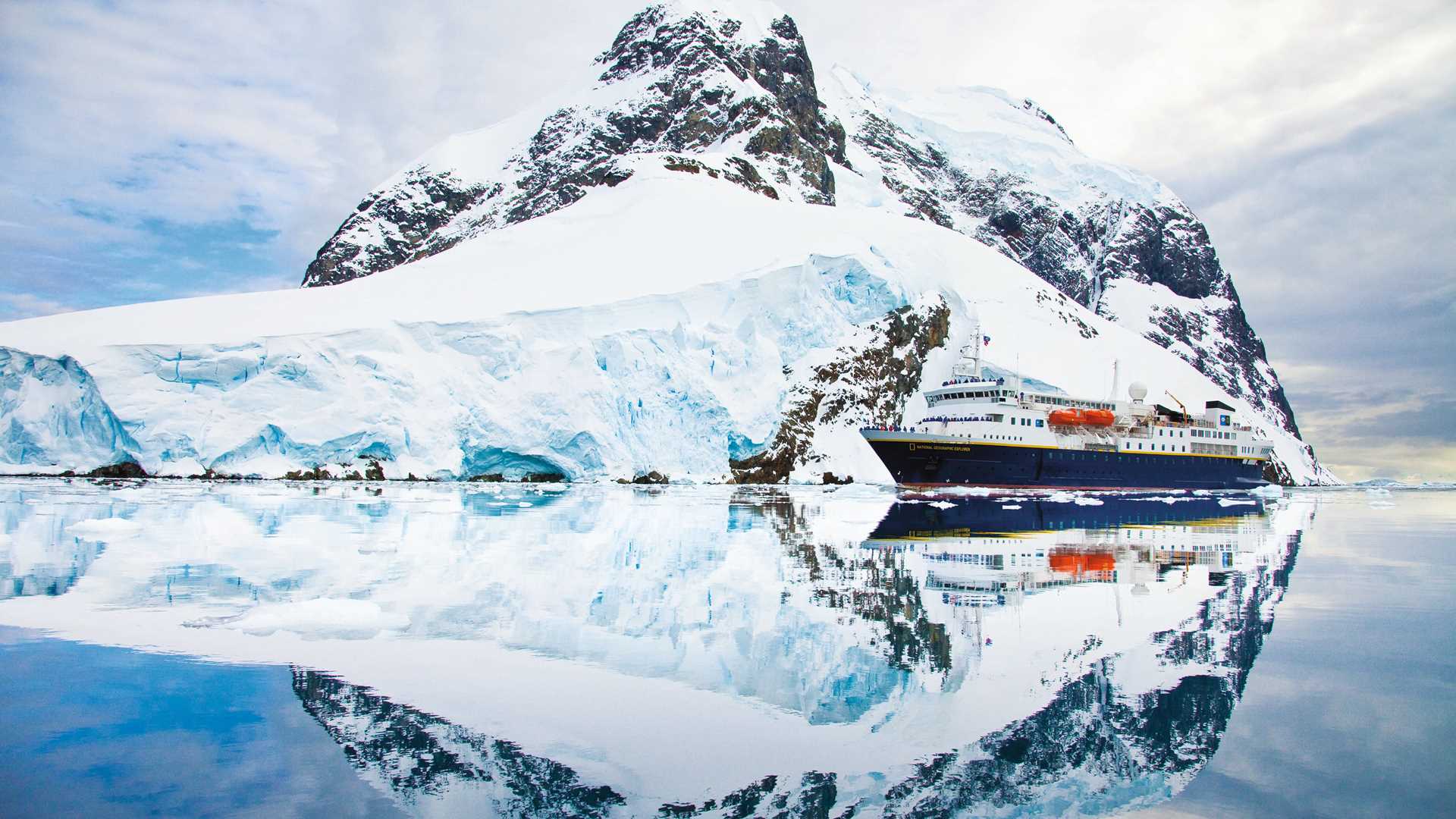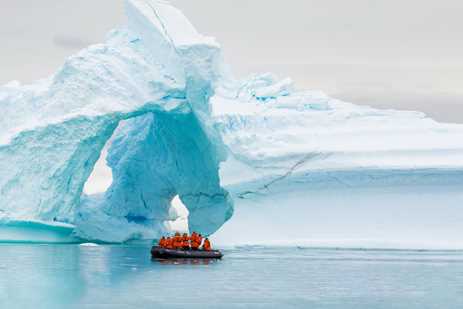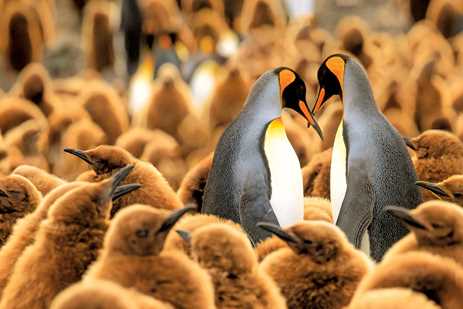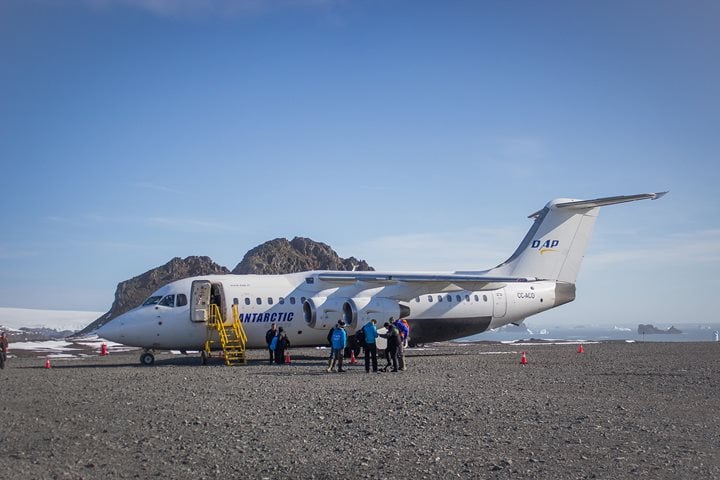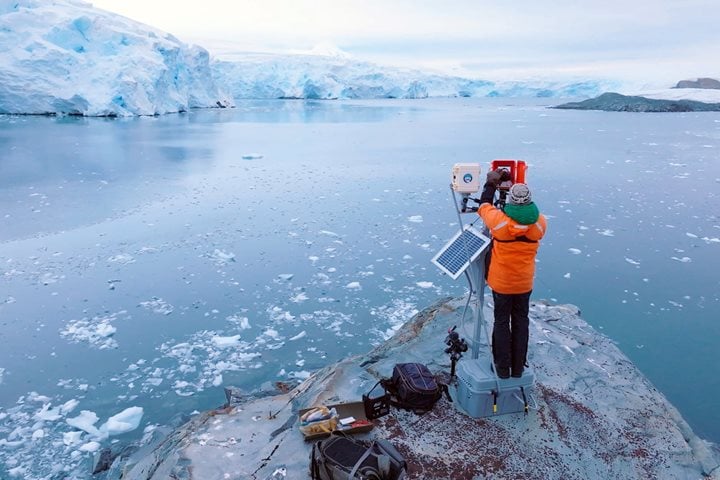Once reserved for researchers and only the most daring of explorers, Antarctica’s overwhelming beauty is now witnessed annually by nearly 75,000 visitors—making it imperative to plan your voyage around 12-18 months in advance. For much of the year, conditions are inhospitable, so the austral summer (November to March) is the best and only time to tour this polar paradise. On the Antarctic Peninsula, the northernmost part of the continent, daily temperatures range from 24-40 degrees Fahrenheit and 20-some hours of daylight ensure not a moment will be missed. Get Inspired by Photos, Videos, Webinars, Stories, and Exclusive Offers. Sign Up
Photo: Michael S. Nolan
While the grandeur of Antarctica is on display no matter when you visit, each month provides its own window of weather and wildlife. That means the best time to go will depend on which of the White Continent’s calls you’re most keen to answer. Dream of kayaking through an ethereal museum of ice art? Photographing fluffy penguin chicks in their natural habitat? Or witnessing a midnight sunset from the comfort of a geodesic glass igloo? Antarctica holds all of this and more. Plus, the subantarctic islands of South Georgia and the Falklands have their own seasonal spectacles to take into account.
In these ephemeral lands of ice, however, there’s no way to know exactly what’s in store. That’s all part of the thrill, especially with an impassioned crew at the helm, informed by 55 years of experience navigating the seventh continent, as well as the legendary Drake Passage. From the premier voyage in 1966 when Lars-Eric Lindblad brought the very first citizen explorers to Antarctica to today, the National Geographic-Lindblad Expeditions fleet of ice-class vessels continues to pioneer new possibilities.
Read on to learn about some of the highlights each month has to offer to help you plan your ultimate Antarctic adventure.
November
Swaths of still-intact sea ice, massive ice floes and a gleaming blanket of virgin snow, all awash in legendary Antarctic light: November is a landscape photographer’s dream. This is quintessential Antarctica and—when you’re the only sign of humanity around—it is the closest one can come to a glimpse back in time to the Ice Age. Early-season ice is more than just photogenic; it also tends to be more stable. When conditions are just right, your veteran captains can deftly "park" the ship in the frozen fast ice, allowing guests to disembark on untouched snow to hike, snowshoe or even cross-country ski in total tranquility.
Then, prepare your senses for the polar opposite of calm, as gentoo, Adélie and chinstrap penguins are all heading ashore to mate. Colonies alight with a flurry of courtship activity. Watch for flirty flipper-waving, stone thievery and even some cacophonous clashes over nesting space that will hold your attention closer than any reality television series could.
Spring blooms sooner in the subantarctic islands. By October and November, the Falklands’ picturesque shores are bursting with wildflowers and rockhopper, macaroni and Magellanic penguins. On South Georgia’s sandy beaches, the “Serengeti of the Southern Ocean” is on full display. Witness the heart-thumping high drama of 1,000-pound male southern elephant seals fiercely competing for mates.
Watch as National Geographic Photography Expert Jasper Doest shares tips on creating compelling images in the subantartic islands.
December
With summer’s official arrival, the days stretch long and temperatures poke their heads above freezing. It’s an excellent month for wildlife. Resident marine mammals like orcas abound and penguin rookeries are bustling. You may even spot females waddling about with their eggs balanced atop their feet. Chicks will begin to hatch around mid-month.
Humpback whales return to the Southern Ocean in December. One of four baleen species—alongside minke, blue and fin whales—humpbacks have made a considerable comeback from near-extinction, with thousands of individuals spotted in 2020 in the nutrient-rich waters off the Peninsula. This seldom-dived coast harbors a shockingly vibrant underwater world. Clearer waters in the early season allow undersea specialists to document an array of fascinating crustaceans, anemones, nudibranchs and other creatures with top-of-the-line underwater cameras so guests can explore the frigid underwater realm from the comfort of the ship.
Photo: Michael S. Nolan
Over in South Georgia, December marks peak mating season for king penguins, who are known for their boldness in both plumage and personality. More than 150,000 pairs crowd the shore as far as the eye can see for an unforgettable spectacle. Wandering albatrosses return around this time as well to nest in the windswept tussock grasses after having spent two years airborne, riding ocean winds with their impressive 11-foot wingspans. Elephant seals have departed, clearing the beaches for 95 percent of the world’s fur seals to breed.
January
January is an exciting time as fluffy newborn penguins begin to explore and comically chase down their parents for food. Adventurous chicks also mean active predators—namely the prehistoric-looking leopard seal whose fierce reputation comes from its aggressive pursuit of penguins. Leopard, crabeater and Weddell seals have birthed their doe-eyed pups by now, which can be spotted snoozing on ice floes or bobbing between bergy bits. The warmer weather and near-endless sunlight set glaciers off into their own form of “breeding,” calving thunderous icebergs into the sea.
By month’s end, Antarctica’s penguin chicks start to fledge, but not without their fair share of adolescent awkwardness. Mid-molt into their sleek adult feathers, patches of juvenile down form mullets, tutus and other delightfully strange stylings.
January in the Falklands is a great time to observe rockhopper and gentoo penguin chicks huddling into crèches (French for crib) for warmth while their parents hunt. In South Georgia, early-season king penguin eggs are hatching by now, peppering in the juvenile fluffy brown “Oakum boys” throughout the masses of adults and a plethora of playful fur seal pups.
February
After two months of near-endless summer sun, pack ice weakens significantly by February, expanding your exploration borders to lower latitudes. Access historic sites like Snow Hill Hut where, in 1902, Swedish explorers ended up stranded for two years before being rescued—and perhaps even make a little history of your own.
Snow Hill Island is also one of the likeliest spots for an increasingly rare encounter with an Antarctic icon: the Emperor penguin. Weighing as much as 99 pounds and standing up to four feet tall, these majestic creatures nest on sea ice—likely never setting foot on land.
Photo: Michael S. Nolan
February is primetime for whales: minke, sperm, southern right and humpback whales are all abundant. Without the pressing need to hunt, these highly intelligent cetaceans can flex their curiosity—sometimes swimming right near the boat. Encounters with blue whales and fin whales, the planet’s largest living mammals, are never guaranteed, of course, but are becoming more common especially in waters with deep drop offs.
March
Several February voyages conclude before mid-month of March, but those first few weeks are a magical time. Fading daylight hours foster the glorious return of sunrises and sunsets, painting the skies in a near-surreal colorscape. In the water, algae blooms green and pink and marine mammals are still quite active, with migratory baleen whales continuing to fill up on krill before heading back north. In calmer waters, one may have the privilege to observe the beginnings of Antarctic sea ice formation: slicks of grease ice in various phases of thickening into the intertwined fingers of dark nilas ice.
In March, sailing itineraries save the subantarctic isles for the return journey, as they have a slower transition into fall. Fur seal pups still remain on South Georgia’s shores, waiting for adults to lead them out to sea. The firstborn king penguin fledglings are at their plumpest and wandering albatross chicks are starting to hatch, eager for their pre-winter feasts.
Watch this video to experience all the stunning ice and wildlife you'll see in Antarctica depending on what season you travel.
National Geographic-Lindblad Expeditions now offers travelers two new, more time-efficient ways to discover Antarctica with itineraries that fly over the legendary Drake Passage. Learn more.

